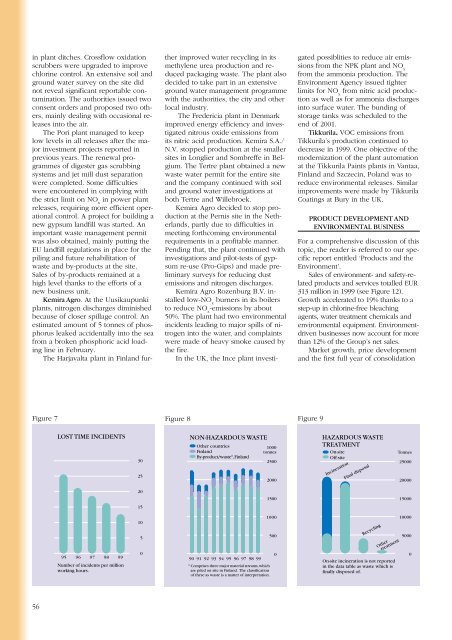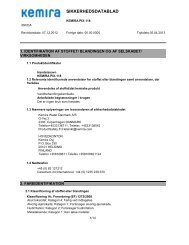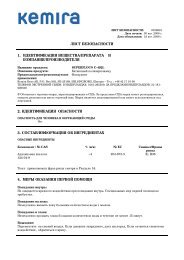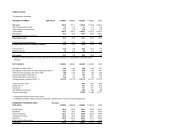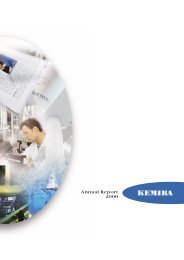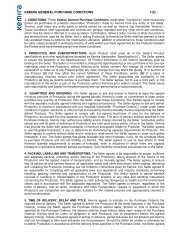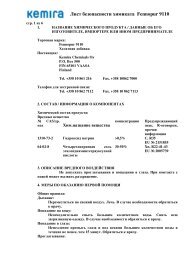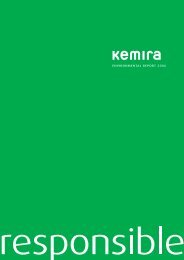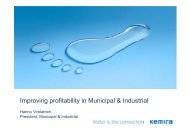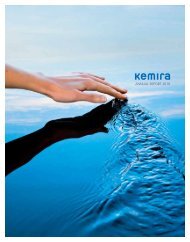Annual Report 1999 - Kemira
Annual Report 1999 - Kemira
Annual Report 1999 - Kemira
You also want an ePaper? Increase the reach of your titles
YUMPU automatically turns print PDFs into web optimized ePapers that Google loves.
in plant ditches. Crossflow oxidation<br />
scrubbers were upgraded to improve<br />
chlorine control. An extensive soil and<br />
ground water survey on the site did<br />
not reveal significant reportable contamination.<br />
The authorities issued two<br />
consent orders and proposed two others,<br />
mainly dealing with occasional releases<br />
into the air.<br />
The Pori plant managed to keep<br />
low levels in all releases after the major<br />
investment projects reported in<br />
previous years. The renewal programmes<br />
of digester gas scrubbing<br />
systems and jet mill dust separation<br />
were completed. Some difficulties<br />
were encountered in complying with<br />
the strict limit on NO x<br />
in power plant<br />
releases, requiring more efficient operational<br />
control. A project for building a<br />
new gypsum landfill was started. An<br />
important waste management permit<br />
was also obtained, mainly putting the<br />
EU landfill regulations in place for the<br />
piling and future rehabilitation of<br />
waste and by-products at the site.<br />
Sales of by-products remained at a<br />
high level thanks to the efforts of a<br />
new business unit.<br />
<strong>Kemira</strong> Agro. At the Uusikaupunki<br />
plants, nitrogen discharges diminished<br />
because of closer spillage control. An<br />
estimated amount of 5 tonnes of phosphorus<br />
leaked accidentally into the sea<br />
from a broken phosphoric acid loading<br />
line in February.<br />
The Harjavalta plant in Finland further<br />
improved water recycling in its<br />
methylene urea production and reduced<br />
packaging waste. The plant also<br />
decided to take part in an extensive<br />
ground water management programme<br />
with the authorities, the city and other<br />
local industry.<br />
The Fredericia plant in Denmark<br />
improved energy efficiency and investigated<br />
nitrous oxide emissions from<br />
its nitric acid production. <strong>Kemira</strong> S.A./<br />
N.V. stopped production at the smaller<br />
sites in Longlier and Sombreffe in Belgium.<br />
The Tertre plant obtained a new<br />
waste water permit for the entire site<br />
and the company continued with soil<br />
and ground water investigations at<br />
both Tertre and Willebroek.<br />
<strong>Kemira</strong> Agro decided to stop production<br />
at the Pernis site in the Netherlands,<br />
partly due to difficulties in<br />
meeting forthcoming environmental<br />
requirements in a profitable manner.<br />
Pending that, the plant continued with<br />
investigations and pilot-tests of gypsum<br />
re-use (Pro-Gips) and made preliminary<br />
surveys for reducing dust<br />
emissions and nitrogen discharges.<br />
<strong>Kemira</strong> Agro Rozenburg B.V. installed<br />
low-NO x<br />
burners in its boilers<br />
to reduce NO x<br />
-emissions by about<br />
50%. The plant had two environmental<br />
incidents leading to major spills of nitrogen<br />
into the water, and complaints<br />
were made of heavy smoke caused by<br />
the fire.<br />
In the UK, the Ince plant investigated<br />
possiblities to reduce air emissions<br />
from the NPK plant and NO x<br />
from the ammonia production. The<br />
Environment Agency issued tighter<br />
limits for NO x<br />
from nitric acid production<br />
as well as for ammonia discharges<br />
into surface water. The bunding of<br />
storage tanks was scheduled to the<br />
end of 2001.<br />
Tikkurila. VOC emissions from<br />
Tikkurila’s production continued to<br />
decrease in <strong>1999</strong>. One objective of the<br />
modernization of the plant automation<br />
at the Tikkurila Paints plants in Vantaa,<br />
Finland and Szczecin, Poland was to<br />
reduce environmental releases. Similar<br />
improvements were made by Tikkurila<br />
Coatings at Bury in the UK.<br />
PRODUCT DEVELOPMENT AND<br />
ENVIRONMENTAL BUSINESS<br />
For a comprehensive discussion of this<br />
topic, the reader is referred to our specific<br />
report entitled ‘Products and the<br />
Environment’.<br />
Sales of environment- and safety-related<br />
products and services totalled EUR<br />
313 million in <strong>1999</strong> (see Figure 12).<br />
Growth accelerated to 19% thanks to a<br />
step-up in chlorine-free bleaching<br />
agents, water treatment chemicals and<br />
environmental equipment. Environmentdriven<br />
businesses now account for more<br />
than 12% of the Group’s net sales.<br />
Market growth, price development<br />
and the first full year of consolidation<br />
Figure 7 Figure 8 Figure 9<br />
LOST TIME INCIDENTS<br />
30<br />
25<br />
NON-HAZARDOUS WASTE<br />
Other countries<br />
Finland<br />
By-product/waste*, Finland<br />
1000<br />
tonnes<br />
2500<br />
2000<br />
HAZARDOUS WASTE<br />
TREATMENT<br />
On-site<br />
Off-site<br />
Incineration<br />
Final disposal<br />
Tonnes<br />
25000<br />
20000<br />
20<br />
1500<br />
15000<br />
15<br />
10<br />
5<br />
0<br />
95 96 97 98 99 90 91 92 93 94 95 96 97 98 99<br />
Number of incidents per million<br />
working hours.<br />
* Comprises three major material streams, which<br />
are piled on site in Finland. The classification<br />
of these as waste is a matter of interpretation.<br />
1000<br />
500<br />
0<br />
Recycling<br />
Other<br />
treatment<br />
On-site incineration is not reported<br />
in the data table as waste which is<br />
finally disposed of.<br />
10000<br />
5000<br />
0<br />
56


